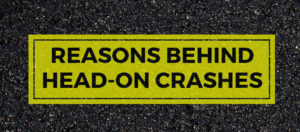 Car crashes can occur in many different ways, with drivers often crashing into the rear or side of other vehicles. One of the most dangerous types of crashes is a head-on collision, which happens when the front of one vehicle collides into the front end of another vehicle. These collisions tend to happen when both vehicles are in motion and often at high speeds. For this and other reasons, head-on collisions can cause some of the most catastrophic and often fatal injuries. According to a report by the Department of Transportation (DOT),1 an estimated 18 percent of crashes outside of intersections involve a head-on crash.
Car crashes can occur in many different ways, with drivers often crashing into the rear or side of other vehicles. One of the most dangerous types of crashes is a head-on collision, which happens when the front of one vehicle collides into the front end of another vehicle. These collisions tend to happen when both vehicles are in motion and often at high speeds. For this and other reasons, head-on collisions can cause some of the most catastrophic and often fatal injuries. According to a report by the Department of Transportation (DOT),1 an estimated 18 percent of crashes outside of intersections involve a head-on crash.
Cars have many safety features to try to reduce the risk of injuries in a head-on collision and other types of car crashes. Crumple zones, bumpers, seatbelts, and airbags are all intended to keep motorists inside of the vehicle and to absorb most of the impact of the crash. However, despite all of these standard safety features, many victims sustain life-changing injuries in head-on collisions.
Many head-on crashes occur because a driver or another party acted in a negligent manner. If a negligent party caused your accident, you have the right to hold that party accountable and receive compensation for your losses.
Causes Of Head-On Collisions
Head-on crashes can happen for many different reasons. The following are only some examples of why these extremely dangerous accidents may occur:
- Drunk driving — Drunk drivers are notorious for swerving back and forth, often leaving their designated lane. If a drunk driver swerves too far to the left, they may cross over the center yellow line and collide with an oncoming car. Head-on crashes can also happen if a drunk driver is going the wrong way2down the highway or a one-way street.
- Fatigued driving — Fatigued driving can affect a driver’s concentration and they may stray from their intended lane. In addition, very fatigued drivers may completely fall asleep while driving, which often results in them unknowingly turning the wheel and driving into other lanes. Sleeping drivers can cross double lines or medians and can cause head-on accidents.
- Distracted driving — Often, if you see a driver swerving in a lane, it would not be surprising to pass them and learn that they were texting or otherwise using a smartphone. Unfortunately, many texting or distracted drivers do depart from their lanes and into oncoming traffic lanes, which often results in hitting another vehicle head-on.
- Improper passing — Every driver should know that a double yellow line means that you should not pass another driver. However, many impatient drivers think they are fast or experienced enough to pass cars on a two-lane highway regardless of a double yellow center line. Too often, the passing driver does not have the visibility to see oncoming cars in the passing lane and often cannot brake or get back over in time to avoid a head-on crash.
- Rural roads — Statistics show3 that almost half of all head-on collisions happen on rural highways. Rural highways are often two narrow lanes traveling opposite directions. These roads are often winding with many hills that can make it difficult to see oncoming traffic. In addition, because of the lack of law enforcement officers on rural roads, many people are prone to traveling these already dangerous roads at high speeds. All of these circumstances can easily lead to cars straying into the other lane and hitting an oncoming car.
- Third party drivers — In some cases, a third car that was not actually involved in the crash can cause the crash to happen. Imagine that you are driving in the left lane and, all of a sudden, a car tries to change lines right where you are driving. You may jerk the wheel to avoid crashing into that car, however, you may then cross over into oncoming lanes and can be involved in a head-on collision through no fault of your own.
- Road hazards — Potholes, cracks, improper lane markings, objects in the street, and other hazards can cause a driver to either swerve or lose control of their car, which can regularly lead to a serious head-on crash.
Contact A Philadelphia Auto Accident Lawyer For A Free Consultation
If you have been injured in a head-on crash, you should not hesitate to discuss your legal rights with an experienced car accident attorney in Philadelphia. Call The Levin Firm Personal Injury Lawyers at 215-825-5183 to discuss your case today.